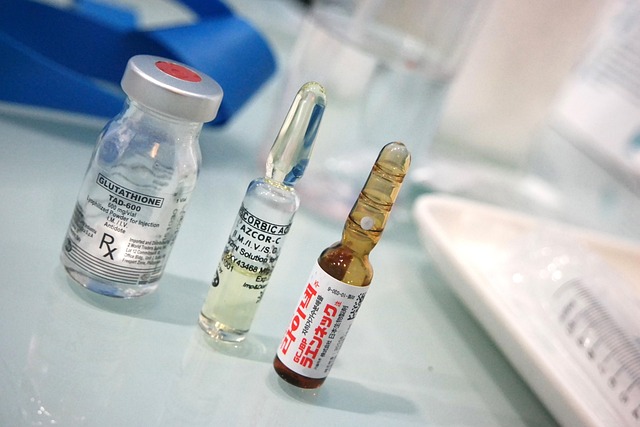Semaglutide injectable form is a leading diabetes medication that regulates blood sugar through a natural hormone mimicry. Its convenience and flexibility in weekly or biweekly dosing enable patients to self-administer with proper training on subcutaneous injection techniques. Comprehensive patient training programs, including practical demonstrations, written instructions, personalized sessions, and regular follow-ups, enhance confidence and adherence. Starting with understanding the device, practicing on dummy syringes, and learning hygiene practices, patients overcome challenges like needle phobia. Safety protocols, including sterile handling and proper disposal, are crucial. Monitoring progress through set goals and regular assessments enables patients to gain independence and competence in managing their treatment. Online resources and support groups further facilitate continuous learning and encouragement.
Patient training for self-administering injections, particularly with semaglutide’s innovative injectable form, is a pivotal step in improving healthcare outcomes. This comprehensive guide explores why such training is essential, delving into key components of effective programs and practical steps to master injection techniques. We navigate common challenges, emphasize safety and hygiene, and provide strategies for tracking progress. Additionally, resources and support options are highlighted to ensure continuous learning and confidence in self-injecting semaglutide.
Understanding Semaglutide and Its Injectable Form

Semaglutide is a medication primarily known for its role in managing type 2 diabetes. It mimics a natural hormone that regulates blood sugar levels, offering a novel approach to glycemic control compared to traditional insulin therapies. The injectable form of semaglutide is a convenient and effective way for patients to self-administer this medication. This formulation allows for weekly or biweekly dosing, providing flexibility and potentially improving adherence to treatment plans.
The semaglutide injectable form is typically administered as a subcutaneous injection, which means it’s injected just beneath the skin. Patients are trained on proper injection techniques, including how to choose the right injection site, prepare the dose, and safely dispose of used needles. Understanding the unique properties of semaglutide and its delivery method is crucial for patients to gain confidence in self-injecting and achieve better diabetes management.
The Importance of Patient Training for Self-Administration

Patient training for self-administering injections, such as those involving the semaglutide injectable form, is a critical aspect of healthcare that empowers individuals to take control of their treatment. This process ensures patients understand how to safely and effectively deliver medication to themselves, fostering independence and self-reliance in managing their health conditions.
Proper training enhances adherence to treatment plans, as it equips individuals with the knowledge and skills to perform injections accurately. This is particularly important for long-term therapies like semaglutide, where consistent administration is key to achieving desired therapeutic outcomes. Through training, patients gain confidence, reducing anxiety associated with self-injection and promoting a sense of competence in their healthcare management.
Key Components of an Effective Training Program

An effective patient training program for self-administering injections, such as the semaglutide injectable form, should include several key components to ensure successful adoption and adherence. Firstly, practical demonstrations play a pivotal role in teaching patients the step-by-step process of preparing and injecting the medication. This hands-on approach allows them to observe and mimic the actions, fostering confidence and accuracy. Secondly, comprehensive written materials, including easy-to-understand instructions and visual aids, serve as valuable references for patients to review at their leisure. These resources should cover topics like proper storage, expiration dates, and signs of potential adverse reactions.
Additionally, one-on-one sessions with healthcare professionals offer personalized guidance tailored to each patient’s unique needs and learning style. This interactive format addresses any concerns or questions promptly, enhancing the overall training experience. Regular follow-up assessments are also essential to gauge patients’ understanding and provide additional training where needed. Such a structured program not only empowers patients to manage their injections independently but also promotes medication adherence, leading to improved health outcomes.
Step-by-Step Guide to Learning Injection Techniques

Learning to self-administer injections is a crucial step for patients, especially those managing chronic conditions with medications like semaglutide, available in injectable forms. It empowers individuals to take control of their healthcare and ensure consistent dosing. A step-by-step guide can make this process less daunting. Start by familiarizing yourself with the injection device – understand its parts and how it works. Practice on a training device or dummy syringe to get a feel for the correct technique, including proper hand placement and needle insertion angle.
Next, locate the appropriate injection site as per medical advice. Clean the skin thoroughly with alcohol wipes before inserting the needle. With steady hands, inject the medication slowly and carefully, ensuring it’s delivered correctly. After administering the dose, withdraw the needle and dispose of it safely. It’s essential to practice regularly and seek feedback from healthcare professionals for confidence and precision in self-injecting semaglutide.
Common Challenges and How to Overcome Them

Many patients face challenges when learning to self-administer injections, especially with complex medications like semaglutide, an injectable form used for diabetes management. Common difficulties include needle phobia, fear of pain, and difficulty in accurately measuring dosages. Overcoming these obstacles requires a supportive environment and tailored education. Healthcare professionals can help by offering step-by-step guidance, ensuring patients feel comfortable with the process. Visual aids and practice sessions with simulated injections can significantly reduce anxiety.
Additionally, providing clear instructions and using easy-to-understand language is vital. Patients should be encouraged to ask questions and address any concerns. Regular follow-ups and feedback sessions can further assist in overcoming challenges, making self-injection a more manageable task. This supportive approach ensures patients feel empowered and confident in their ability to manage their health effectively.
Ensuring Safety and Hygiene During Self-Injection

When training patients on self-administering injections, a significant focus must be placed on safety and hygiene to prevent any potential risks or complications. It’s crucial to educate patients about the proper techniques for preparing and administering semaglutide injectable forms, including sterile needle handling and injection sites. Emphasize the importance of using clean, unopened vials and syringes to avoid contamination from bacteria or other pathogens.
Instruct patients to always wash their hands thoroughly before and after the injection process. They should also ensure that the injection site is clean, dry, and free from any visible signs of infection. Proper disposal of used needles and syringes is critical; patients should be trained on how to dispose of these items safely according to local regulations. These precautions help maintain a sterile environment, minimizing the risk of adverse reactions or infections associated with self-injection practices.
Monitoring and Tracking Progress: Setting Realistic Goals

Patient progress monitoring is a vital aspect of self-administering injections, especially with medications like semaglutide, which is available in injectable forms. Healthcare providers should set realistic goals tailored to each patient’s needs and abilities. This involves regular assessments to track their understanding, adherence, and skill level in performing the injection procedure. By setting achievable milestones, patients can build confidence and competence over time.
For instance, initial goals might focus on correctly identifying the injection site and preparing the dose, while subsequent objectives could include demonstrating proper needle insertion techniques and injectability without assistance. This progressive approach ensures patients are well-prepared to manage their treatment independently, fostering a sense of autonomy and empowerment in their healthcare journey.
Resources and Support for Continuous Learning

Patient training for self-administering injections, especially with complex drugs like semaglutide injectable form, requires ongoing support and resources for continuous learning. Many healthcare providers offer online platforms and digital tools that provide step-by-step guides, video tutorials, and interactive quizzes to reinforce proper injection techniques. These resources are invaluable, as they allow patients to learn at their own pace and revisit challenging concepts whenever needed.
Community forums and support groups also play a crucial role in fostering continuous learning. Patients can share experiences, ask questions, and offer encouragement to one another, creating a network of support that goes beyond traditional healthcare settings. This peer-to-peer approach often leads to practical insights and strategies for managing self-injection routines effectively.
